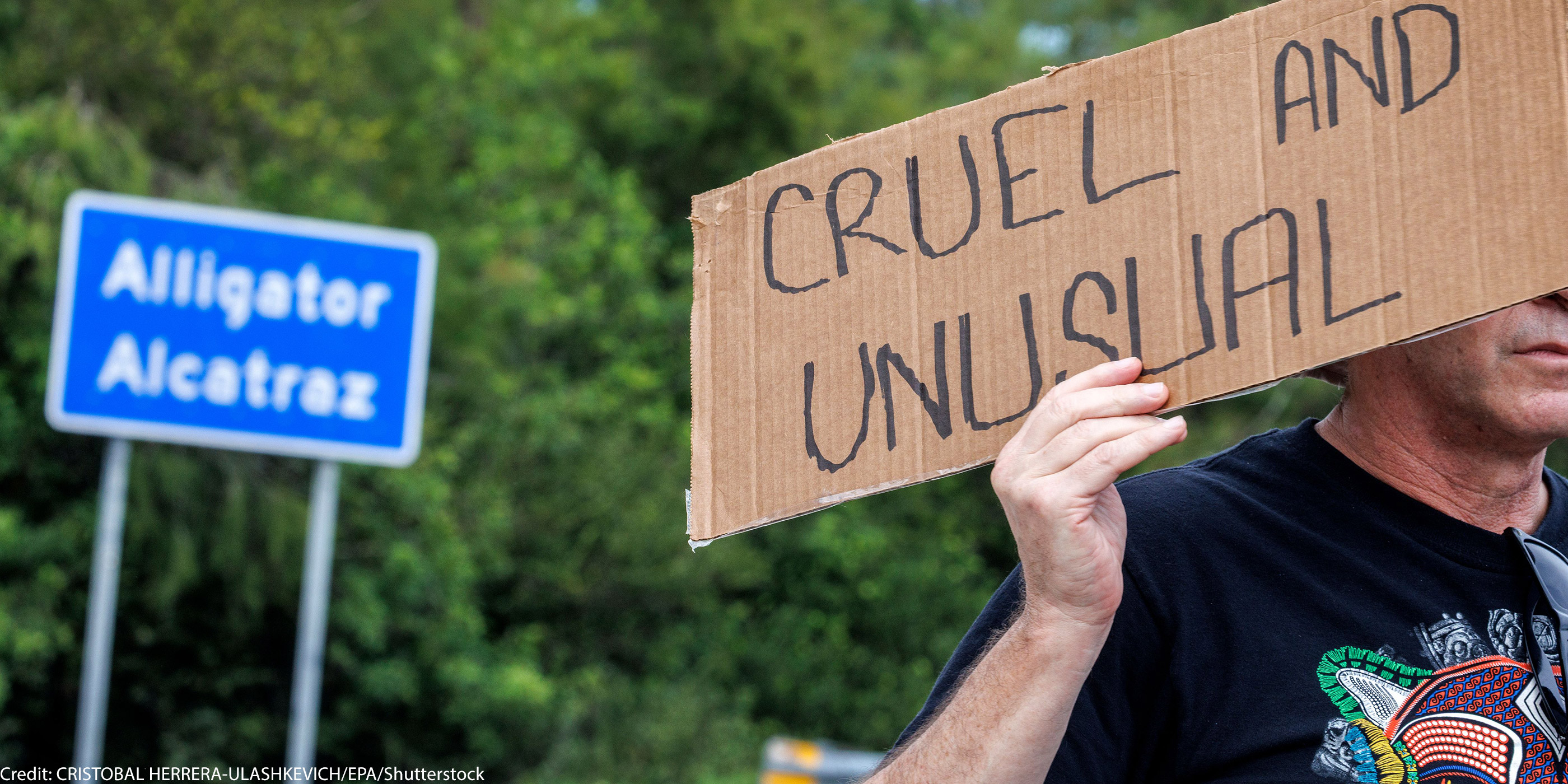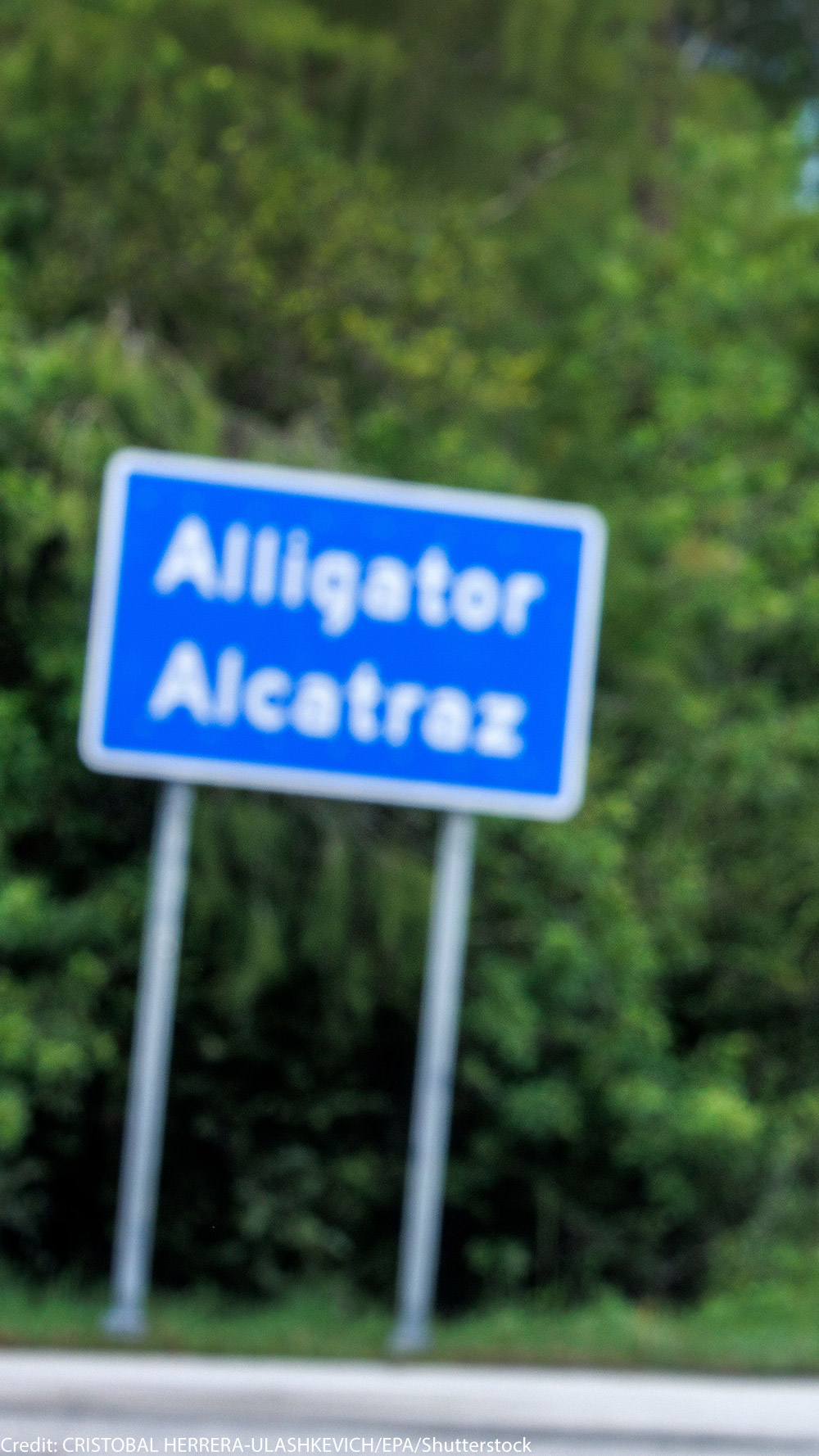Florida's Secretive Immigration Detention Center, Explained


Deep in the Florida Everglades, a new immigration detention facility has appeared almost overnight. ItŌĆÖs the latest example of the Trump administrationŌĆÖs extreme approach to immigration enforcement, and itŌĆÖs drawing significant, well-deserved outrage.
In just eight days, a former airstrip was converted into a large-scale immigration detention facility that now holds more than 700 detainees. Florida Attorney General James Uthmeier dubbed it ŌĆ£Alligator AlcatrazŌĆØ to evoke the extreme isolation and cruel conditions of the now shut down federal prison -- leveraging the Everglades' vibrant wildlife as a potentially lethal barrier to human being
While Florida Governor Ron DeSantis and the Trump administration describe it as a solution, the harsh, inhumane conditions and limited access to legal counsel pose a serious threat to human rights and due process. It is all part of Donald TrumpŌĆÖs broader policy of mass detention and deportation that disregards legal protections and basic human dignity.
Below, we explain what you need to know about the cruelly dubbed ŌĆ£Alligator Alcatraz,ŌĆØ and what it reveals about the Trump administrationŌĆÖs escalating approach to immigration enforcement.
The Camp Was Built in Secret and Without Proper Approval
The state of Florida never held a public hearing, obtained full local approval, or went through an environmental review process before seizing the county-owned land used for this facility. Governor DeSantis said he was acting in response to a federal request and authorized the project under granted by a 2023 executive order. Using these powers, he bypassed laws intended to safeguard public transparency and environmental protection, citing an alleged immigration ŌĆ£emergencyŌĆØ as justification.
Local officials in Collier County, where the facility is located, were reportedly of the site until days before its opening. This group includes the countyŌĆÖs planning and zoning director, emergency management director, and a commissioner, who only learned about it when DeSantis, Trump, and federal officials toured the site.
This facility sets a troubling precedent by pushing the boundaries of state authority in immigration enforcement. It comes at a time when Congress has recently increased funding by for ICE detention and deportation efforts, and when the federal government holds primary responsibility for immigration enforcement.
Conditions Inside the Camp Are Dangerous and Inhumane
The first group of detainees arrived at the facility on, and in the short time since, hundreds are now detained in makeshift tents and cages, exposed to extreme heat, mosquitoes, and unsanitary conditions, and surrounded by snakes and alligators. Congressional visitors reported cages holding 30 or more individuals at temperatures near 100 degrees. Detainees report minimal and sometimes contaminated food, bug infestations, overflowing toilets, and lack of medical care ŌĆö conditions so severe that they have led the detainees to stage a.

Immigrants' Rights

Immigrants' Rights
Although the facility is promoted as having capacity for up to 3,000 detainees ŌĆö with Department of Homeland Security (DHS) officials claiming it could eventually hold ŌĆö it lacks permanent infrastructure. The facility depends on temporary Federal Emergency Management Agency (FEMA) trailers, portable air conditioning units, and mobile power and water systems. While government officials have described it as a ŌĆ£low-costŌĆØ facility, operating expenses are projected at annually, initially paid by Florida taxpayers and later reimbursed by federal agencies. Even officials involved in planning the site that the harsh conditions were deliberately designed to encourage undocumented people who are already in America to self-deport.
People Are Being Denied Legal Access and Due Process
Multiple lawyers reported being turned away by armed National Guard and state police officers at the entrance gate. Detainees have no reliable way to make confidential calls to lawyers. Documents shared between attorneys and clients are being reviewed by staff ŌĆö a direct violation of attorney-client privilege.
DeSantis has that National Guard members serve as immigration judges at the facility, expediting deportations and stripping away independent review. The Florida Governor describes this as cutting through ŌĆ£bureaucracy,ŌĆØ but in reality, it eliminates fair hearings and replaces impartial judges with political appointees.
These practices violate constitutional rights guaranteed by the First and Fifth Amendments, not only for detainees but for their attorneys. In response, on July 16, the 51ŲĘ▓Ķ, the 51ŲĘ▓Ķ of Florida, and Americans for Immigrant Justice filed a lawsuit,C.M. v. Noem, challenging these violations on behalf of detainees and legal service providers.
This Facility is Part of a Larger Expansion of Detention and Deportation
The Everglades detention center is a key example of the Trump administrationŌĆÖs coordinated expansion of detention and deportation nationwide. As of late June, more than immigrants were in ICE custody, many held in local jails because ICE only has funding to house an average of 41,000 people. ICE is increasingly relying on private contractors ŌĆö including for security and facility management ŌĆö to run these operations and has been sending people who are immigrants to El SalvadorŌĆÖs CECOT prison and unconventional detention facilities like.
DeSantis has called the facility, which allows the government to fly people who are immigrants directly out from the old airstrip, a ŌĆ£force multiplierŌĆØ for the administrationŌĆÖs mass deportation effort. Despite the harmful narrative surrounding immigrants and crime, only a third of people at these facilities have been charged for minor offenses, such as illegal reentry or traffic violations.
The Landscape Puts Lives at Risk ŌĆö and the Facility Could Do Permanent Damage to the Environment
The Everglades detention center was built in the middle of a fragile, flood-prone wetland ecosystem, threatening local wildlife and increasing the risk of long-term environmental damage. Trump officials have claimed the swamp ŌĆö with its alligators and snakes ŌĆö adds to the siteŌĆÖs ŌĆ£security.ŌĆØ But thereŌĆÖs nothing secure about housing thousands of people in tents and trailers during hurricane season, especially with only vague plans for evacuation if disaster strikes.
First responders in Collier County have about which agency would be responsible if an emergency occurred at the site. The countyŌĆÖs emergency management director, Dan Summers, was not even informed about the facilityŌĆÖs construction plans. Undocumented people are being housed in repurposed FEMA trailers and tents, the same types often used to shelter people displaced by natural disasters like hurricanes. These structures will do little to protect people from what forecasters predict may be an hurricane season.

Immigrants' Rights
Immigrants' Rights

Immigrants' Rights
Immigrants' Rights
The detention center doesnŌĆÖt only put detainees at risk ŌĆö it could also affect nearby communities, water systems, and the broader region. The Everglades are a protected wetland and a crucial source of drinking water for millions of South Floridians. Placing thousands of people so close to this vital water source raises serious concerns about contamination. Environmental groups, including Friends of the Everglades, the Center for Biological Diversity, and Earthjustice the DeSantis administration on June 27 to stop the project and its harmful impact on the surrounding Big Cypress National Preserve. Not only is the area a key water supply for Floridians, but it is also home to endangered species like the Florida panther, and the disruption caused by the detention center could push them closer to extinction. The facility also violates the rights of the Miccosukee Tribe of Indians of Florida, whose sacred lands border the airport and runway. The tribe has the lawsuit.
Where the Fight Goes from Here
The Trump administration cannot sidestep constitutional protections by relocating detention centers to remote locations or calling them ŌĆ£temporary.ŌĆØ We can expect further expansion and the spread of ICE tactics given the influx of federal funding approved by Congress this summer, including greater involvement of state and local agencies as they seek to broaden their reach across the country.
The 51ŲĘ▓Ķ remains committed to challenging the use of this facility in court, defending the rights of those held without due process, legal access, or safe conditions. Detaining individuals under cruel and chaotic circumstances is not immigration policy ŌĆö it is abuse. We will continue to fight until these unlawful practices end.

